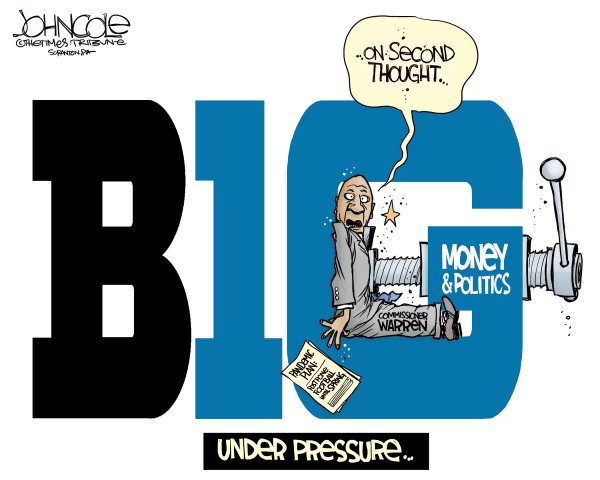
The athletic departments at public universities generate billions of dollars in revenue every year. Private equity investors have noticed. Late last week, Sportico reported that Florida State had hired JPMorgan Chase to explore how its athletic department could raise money from institutional investors.
It could be a winning combination. Despite huge sums already being generated by college football programs, there's more to be had. Private investors could help athletic departments obtain it.
But after schools and investors get their share, what's left for student-athletes? Despite recent court rulings and legislation that provide opportunities for athletes to market themselves, most remain unpaid or underpaid. Meanwhile, athletic departments continue to invest growing amounts in coaching salaries, stadiums and other facilities. It's an imbalance that institutional investors will make worse if the long-term needs of student-athletes aren't prioritized. The business of college sports, and the student-athletes essential to the enterprise, deserve better.
In 2019, the year before Covid shut down college sports for the pandemic, and the last date for which complete data is available, Division I athletics, the highest level of competition sanctioned by the NCAA, generated $15.8 billion in revenue. More than half of it came from football and men's college basketball through ticket sales, royalties and licensing, and - above all - media rights.
For example, in 2012 the Pacific-12 Conference began a 12-year, $3 billion rights deal. Since then, revenues have grown by $509 million. Athletic departments are the beneficiaries: Annual payments to individual Pac-12 schools increased 63% to $31 million a year.
But the Pac-12, which is now on the verge of collapse after more than 100 years, is a prime example of how media rights can shift the college athletics landscape. Two members, UCLA and the University of Southern California, announced last year that they were decamping for the Big Ten Conference, which signed a seven-year, $7 billion deal with multiple networks that will eventually distribute $80 million to $100 million annually to its members.
The dominoes started to fall. Colorado decided to leave for the Big 12 Conference, which agreed last year to a $2 billion deal with Fox and ESPN. A long-awaited new media rights deal for the Pac-12 was apparently unconvincing for the rest of the conference. Washington and Oregon opted to move to the Big Ten last Friday, and three other schools - Arizona, Arizona State and Utah - decided to join Colorado in the Big 12, leaving just four members in the Pac-12.
The moves are critical because media rights typically represent the largest portion of a top-tier athletic department's annual budget. For example, at UCLA it represented 28.5% of the $108.4 million that the athletic department generated in 2019.
Nonetheless, it's tough to make ends meet. According to the NCAA, only 25 of the 130 schools in the Football Bowl Subdivision, a grouping of the most competitive and lucrative college athletic programs, were revenue positive. UCLA had an $18.9 million deficit.
So colleges and conferences are on the hunt for more money. In 2019, the Pac-12 enlisted the Raine Group, an investment bank, to help. The idea was that the bank would recruit investors to provide the conference with upfront money - reportedly as much as $500 million - in return for equity and a piece of its media rights deals.
No deal closed, but the growing demand for live sports content on cable and streaming platforms has served to only boost the value of college athletics, as illustrated by the Big Ten's media rights deal.
That agreement has left many programs feeling undervalued, including Florida State, which is threatening to leave the Atlantic Coast Conference unless it changes how revenue is distributed. Last year, the school received around $40 million from the ACC.
That's not bad, but it trails what schools in the Big Ten and Southeastern Conference receive, and the Seminoles believe there's more to be had. It wants a larger slice of the ACC pie based on its ability to drive TV revenue. Another potential option is to sell future media rights to private equity in exchange for upfront cash.
That money, if it comes, isn't going to flow to the student-athletes who - more than coaches or stadiums - generate the competition that sells media rights. Indeed, a 2020 study estimated that less than 7% of the revenue generated by college football and basketball is returned in academic scholarships and living stipends.
Meanwhile, in 2019, 35% of Division I revenue went to administrative support and coaching compensation. Of course, on the one hand, the disparities between levels of compensation between athletes and coaches make sense. College athletic programs do not share revenue with student-athletes, much less pay them, so revenue is naturally devoted to items that administrators and boosters believe will ensure winning and its benefits.
Recent court rulings and legislation that enables student-athletes to market the rights to their name, image and likeness (or NIL) haven't done much to shift the balance. Most student-athletes never see a penny from NIL. Those who do are independent contractors whose compensation has no relationship to what an athletic department earns from their efforts.
That works to the advantage of colleges and their athletic departments, which can use NIL as a convenient excuse to deflect discussions about sharing their growing revenue streams.
Private equity should force those discussions. As the size of college sports media deals grows, student-athletes at top-tier football schools are increasingly resembling professionals. Practice and travel times take up more time; education, less.
That shift may be in the interests of the small handful of football and basketball players who have reasonable hopes to advance to the NFL and NBA. But it's not in the interests of most student-athletes, or the business of college sports, which depends on student-athletes and amateurism to differentiate itself as a brand.
Outside private investors have an inherent interest in preserving that brand, and ensuring that being a student comes first for college athletes can go a long way in that regard. To do so, they can start by demanding that schools award five-year athletic scholarships instead of the common practice of renewing them annually and further limit weekly time demands on athletes so that they can truly study. Reforms like these will take away some flexibility from overpaid coaches and administrators while boosting the long-term prospects for students.
For private equity, that should be an investment worth making.
Previously:
• Baseball fans should root for gambling's expansion
• PGA merger with LIV Golf is only the beginning
• Farmers are fighting for our right to repair our iPhones
• This column may, or may not, cause an allergic reaction
• There's one Trump idea even libs should like
Minter is a Bloomberg View columnist. He is the author of "Junkyard Planet: Travels in the Billion-Dollar Trash Trade."


 Contact The Editor
Contact The Editor
 Articles By This Author
Articles By This Author